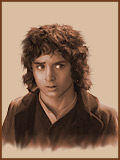.jpg)


J.R.R Tolkien’s novels, particularly The Lord of the Rings, give us a deeper understanding of good and evil. Good is always good and evil is always evil. The one ring is inherently evil. The good character of it’s bearers does not change it’s evil nature. It’s power is always black no matter what the intentions of those who wield it are. It’s power can only bring confusion, hatred and destruction. Our actions are the same. They are either good or evil separate of the outcome they produce.
The forces of good and evil daily clash in our world. Evil and hatred are the causes of war, genocide and terrorism. In his own time Tolkien saw the forces of evil at work in the world. The leaders of Communism and Nazism were empowered by darkness. They destroyed millions of lives and divided the country of Europe. They broke the bonds of peace and trust that existed between nations and set up in their place walls of suspicion and hate. Evil always seeks to destroy, to break apart. Saruman destroys what is beautiful and corrupts it breeding orcs from men and felling trees for factories. (Tolkien, J.R.R. The Lord of the Rings. 50th Anniversary Edition. New York: Houghton Mifflin Company, 2004. Print.) The one ring corrupts those who bear it, from the humble hobbit to the powerful wizard.
Tolkien loved the traditional culture of Great Britain. He was deeply troubled by those who were trying to change. The 20th century saw the modernization of society. Everything from government to education to family life was being redefined. Tolkien saw these as negative reformations and changes. He clung to his old way of life. Even the Catholic Church, which he loved so dearly, was undergoing changes in it’s liturgies and rites. Tolkien stubbornly refused to adhere to the adjustments and continued to recite the words from the old liturgies. (Collins, David. J.R.R Tolkien. First. Minneapolis: Lerner Publications Company, 2005. Print.) Saruman tried to destroy the traditional way of life that existed in Hobbiton replacing Hobbitholes with apartments and gardens with work yards. (Tolkien, J.R.R. The Lord of the Rings. 50th Anniversary Edition. New York: Houghton Mifflin Company, 2004. Print.) The industrialization of Hobbiton reflected Tolkien’s feelings about the changes happening in his own country.
Tolkien offered to the world a solution to it’s troubles in the final chapters of Lord of the Rings. Strengthened by their quest and the peril they together endured, the hobbits returned to the Shire as leaders. They had grown in mind and body and were able to resist the oppression of Saruman and his men. They started a rebellion and drove him from the Shire. They then assisted in rebuilding the community and took on leadership roles. (Tolkien, J.R.R. The Lord of the Rings. 50th Anniversary Edition. New York: Houghton Mifflin Company, 2004. Print.) Tolkien thought that the peoples of Europe could be strengthened by the war. He hoped that a new age would begin and that leaders would rise up and drive the forces of evil form their homes. Then, like in Hobbitton, Europe could truly be rebuilt and have a chance of returning to normal life. He never saw the dawn of this new hope. He died in 1973 in the midst of the Cold War. He, like the protagonist Frodo, left Europe with a great gift, a legacy, and like Frodo was not able to enjoy the fruit of his labor. “I tried to save the Shire, and it has been saved, but not for me. It must often be so Sam, when things are in danger: some one has to give them up, lose them, so that others may keep them.”(Lord of the Rings, The Return of the King. J.RR. Tolkien, chp.9, pg.1029)








Hey, I just took the hobbit quiz! I'm Sam... says a lot about us, doesn't it, best friend?
ReplyDeleteP.S. Christopher is Pippin. Who would have guessed?
ReplyDeleteThat is to awesome!
ReplyDelete